Feature
Searching for Answers
| USF News
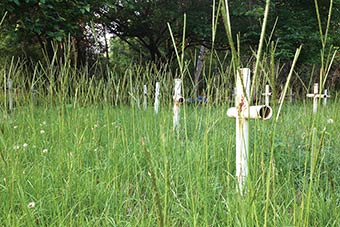
The metal crosses, painted white and rusting, identify 31 possible gravesites on a small knoll about 500 yards from the school. The burial grounds on Boot Hill could be seen from the windows of the dining hall. School documents indicate more than 80 boys died at the school between 1911 and 1973.
Photo by Katy Hennig | USF News
Tucked into the hills of Marianna, a small town in Florida's Panhandle, lies a remote historic cemetery known as "Boot Hill." The only evidence of the burials on the grounds at the the former reform school, which operated for more than 100 years, are 31 metal crosses.
Many questions remain about the Dozier School for Boys and how many children died there over the years. School documents and records provide some clues that more than 80 boys died while incarcerated, many buried in graves beyond the known perimeter of the cemetery.
"Not only were the graves never marked, but there is not a burial plot or map or any specific records that exist today of who was buried there and where they were buried," says Erin Kimmerle, assistant professor of forensic anthropology at USF.
Kimmerle is leading a team of researchers who are trying to unlock some of the mysteries. The team has traveled to the school outside the town of Marianna several times this year. They have spent weeks mapping the area around the gravesites, using ground-penetrating radar to see below the surface, and conducting shovel tests and trenching to look at stratigraphy and soil chemistry.
The team of anthropologists and biologists from USF is now poring over data, hoping to identify the exact location of the bodies of the children who died while in state custody at the school.
The Dozier School
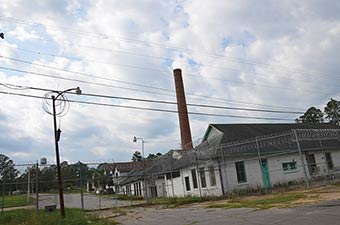
Photo by Katy Hennig | USF News
Once called the Florida Industrial School for Boys, the state reform school housed children ranging in age from 6 to 18 who were sent there to be rehabilitated.
The school, which was renamed the Dozier School for Boys, closed in 2011, and the collection of buildings on the site are nearly empty and falling into disrepair.
In published reports, dozens of men who spent time at the school when they were younger have recounted incidents of abuse at the hands of the staff. The Florida Department of Law Enforcement investigated those allegations in 2009, with no resolution. The school closed two years later.
Questions remain as to how many children are buried around the school property.
USF researchers using ground-penetrating radar (GPR) have identified burial shafts in the wooded areas outside the perimeter of the designated historic cemetery.
Erin Kimmerle

Photo by Katy Hennig | USF News
Erin Kimmerle has spent her professional career searching for answers.
As a forensic anthropologist for the United Nations from 2000-2001, she spent time in the Balkans conducting trauma analysis for cause of death and identification of war victims and assisted the International Criminal Tribunal for the former Yugoslavia.
When she learned about the Dozier School for Boys and the possibility of unmarked graves at the site, she wanted to assist by implementing the expertise that she and fellow researchers could provide.
Fieldwork is key to understanding all of the elements that go into piecing the anthropological puzzle together and the range of experience that forensic and archeological exploration can offer students is unmatched.
"I think it's a wonderful opportunity for the students because they are learning all types of anthropology from preservation of historic cemeteries, to ground-penetrating radar and archeological methods," says Kimmerle, an assistant professor of forensic anthropology at USF.
The students, she says, "are getting a full range of skills out of this project and really have been able to get involved from the archival research all the way to field methods."
-
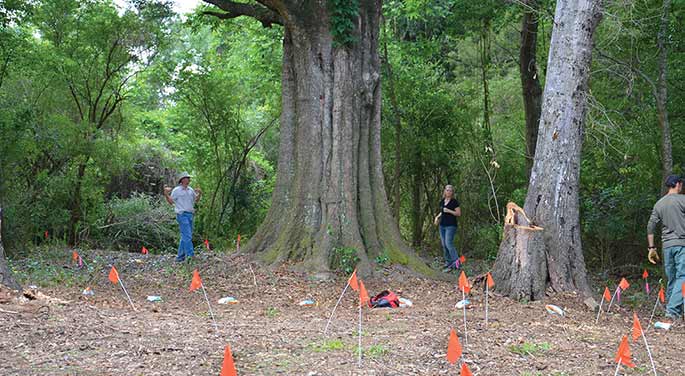
The Research Process
The team from USF works to clear the location of small trees and brush in order for the GPR to run smooth over the area surrounding the old oak tree. Stories over the years reference gravesites at the base of the giant tree. Flags mark the areas where clues were located and anomalies were identified by the GPR.
Photo by Katy Hennig | USF News -
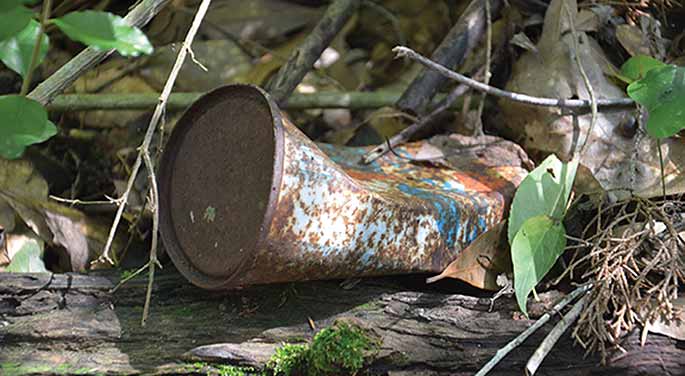
The Research Process
Every item discovered, including this old can, is carefully documented and marked. The items could help pinpoint the time when activity took place near the cemetery.
Photo by Katy Hennig | USF News -
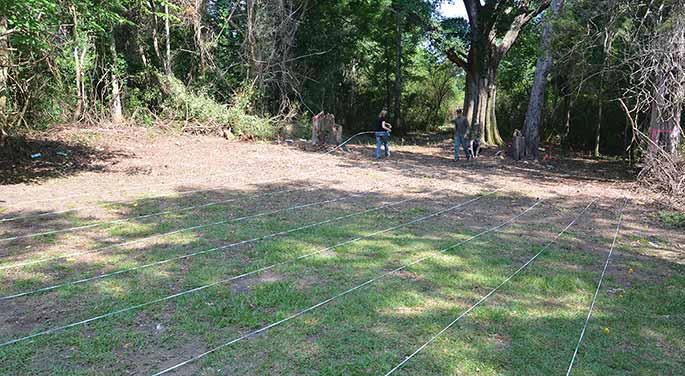
The Research Process
The team carefully measures, marks, and grids out a 14 by 20 meter perimeter to guide the GPR.
Photo by Katy Hennig | USF News -
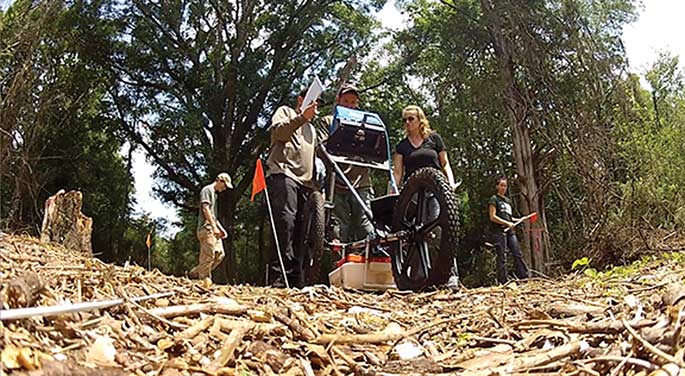
Measurement
Assistant Professor Erin Kimmerle looks on as the team guides the GPR over the gridded area. Wavy lines on the monitor indicate disturbances below the surface of the ground and the GPR consistently registers and collects the data.
Photo by Katy Hennig | USF News -

Measurement
Rich Estabrook, director of The Florida Public Archeology Network in Crystal River and part of USF’s Department of Anthropology, notes coordinates from the GPR scans. All of the measurements gathered will be compiled and put into the GPR software at the anthropology lab, and then deciphered to establish where exactly below the surface the graves are located.
Photo by Katy Hennig | USF News -
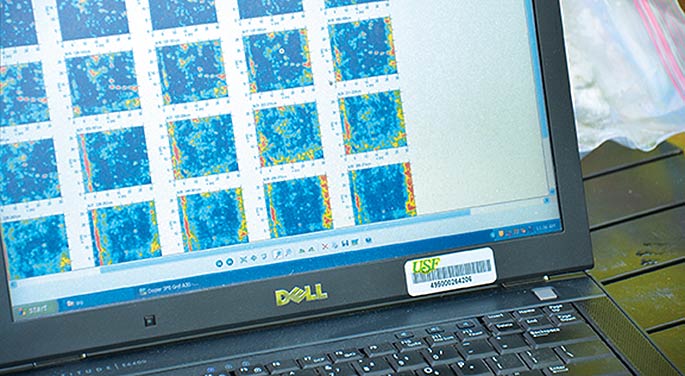
Measurement
In February, when the USF team was at the site, the GPR recognized several areas of interest, or anomalies, that anthropologists are working to explain. The scans show areas in red that are questionable and could indicate a burial.
Photo by Katy Hennig | USF News -
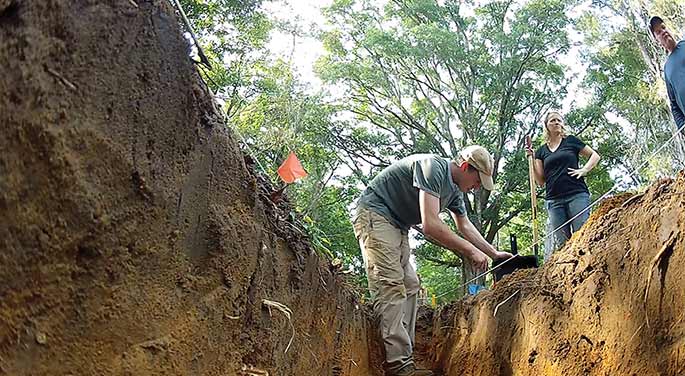
Ground-Truthing
The team excavates shallow trenches in order to take soil samples and document areas where the ground appears to have been disturbed, indicating the location of a grave. Anthropology graduate student John Powell works to even the edges of the half-meter trench, dug across the areas where there are differences in density in the ground, a technique known as "ground-truthing." Florida soil has distributions of dirt over layers of clay; areas on the side of the trench, where the soil and clay are mixed, exhibit signs of previous digging and a grave shaft.
Photo by Katy Hennig | USF News -
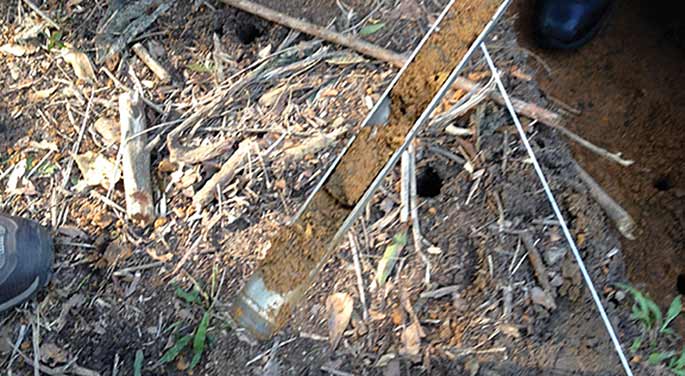
Ground-Truthing
The research team examines core samples of the soil, which indicate a mixture of the clay and soil.
Photo by Katy Hennig | USF News -

Timeline
Marking the timeline at the cemetery is critical to understanding the human activity in the area. A key piece in establishing the events is tree dating. USF graduate biology student Jamie Gluvna extracts core samples of the cedar trees that surround the site to determine when they were planted and where the perimeter of the cemetery may be.
Photo by Katy Hennig | USF News
Kimmerle and the USF anthropology team will continue to sift through the data collected and the GPR software will work to calculate and clarify the anomalies. They will compile and publish a report of findings and hope to provide information to the family members of the boys that may have been buried on Boot Hill.